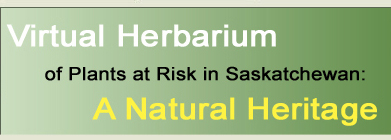
|

|

|

|

|

|

|
|
|
|
|
|
| Sporobolus neglectus Nash | Species Image Gallery (opens in a new window) |
||||||||||||||
| TAXONOMY | |||||||||||||||
| Family: | Poaceae | ||||||||||||||
| Genus: | Sporobolus | ||||||||||||||
| Species Synonyms: | Sporobolus vaginiflorus var. neglectus (Nash Scribn. | ||||||||||||||
| Common Names: | puffsheath dropseed small dropseed |
||||||||||||||
| DISTRIBUTION | |||||||||||||||
| Canada: | southeastern Alberta – southern Saskatchewan – southern Manitoba, Quebec – western New Brunswick | ||||||||||||||
| Saskatchewan: | southern Saskatchewan; Brooking – Souris River Valley | ||||||||||||||
| Ecoregion: | Mixed Grassland, Moist Mixed Grassland | ||||||||||||||
| HABITAT | |||||||||||||||
| Saskatchewan: | dry, often disturbed, gravel barrens | ||||||||||||||
| Associated species: | Hesperostipa comata, Hordeum jubatum, Muhlenbergia racemosa, Plantago elongata, Schedonnardus paniculatum, Setaria viridis, Sporobolus cryptandrus | ||||||||||||||
| RARITY STATUS | |||||||||||||||
| Provincial
Status According to Harms (2003): |
Endangered |
||||||||||||||
| Nature Conservancy Status: | G5 S3 |
||||||||||||||
| Saskatchewan
Species at Risk Status: |
None |
||||||||||||||
| COSEWIC Status: | None |
||||||||||||||
| Sporobolus neglectus is endangered because it is rare and most local populations are small. Possible threats have been identified for this species. | |||||||||||||||
| SPECIES DESCRIPTION | |||||||||||||||
| Height: | 10 – 45 cm | ||||||||||||||
| Roots: | fibrous | ||||||||||||||
| Stems: | caespitose, delicate, erect to decumbent, wiry | ||||||||||||||
| Leaves: | blades 1 – 12 cm long, 0.5 – 2 mm wide, flat to involute, glabrous abaxially, scabrous adaxially; sheaths inflated, mostly glabrous; ligules of hairs, 0.1 – 0.3 mm long; auricles present | ||||||||||||||
| Inflorescence: | panicles terminal and axillary, 2 – 5 cm long, 0.2 – 0.5 cm wide, cylindrical | ||||||||||||||
| Spikelets: | 1.5 – 3 mm long, yellowish, may be purple-tinged | ||||||||||||||
| Flowers: | glumes subequal, shorter than florets, lanceolate to ovate, membranous, glabrous; lemmas 1.5 – 3 mm long, ovate, chartaceous, glabrous; paleas similar to lemmas | ||||||||||||||
| Fruits: | light brown or orange, finely striate | ||||||||||||||
| |||||||||||||||